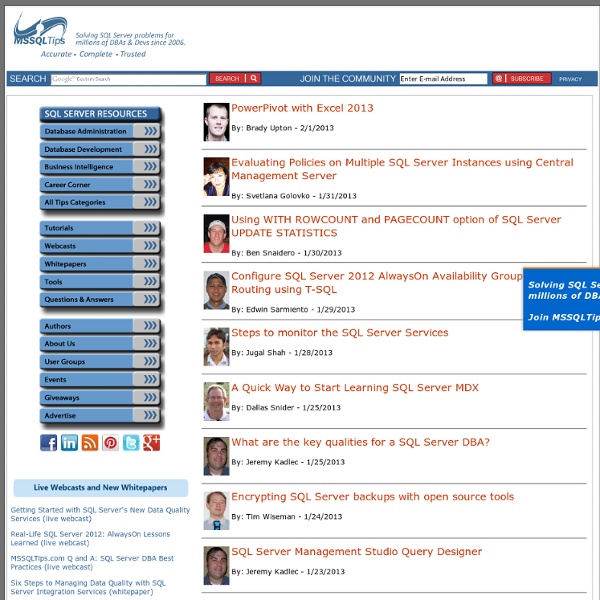



SQL Server Agent SQL Server Agent The SQL Server Agent is a separate process, which is tasked with running database jobs (including jobs setup from a database maintenance plan), raising alerts and notifying operators. Alerts Alerts can be created to flag the occurrence of an error, for example a database log becoming full. These can be raised on an individual error number or on a severity level (different types of errors have different severity levels, for example 017 includes all alerts for insufficient resources). As a minimum alerts should be created to monitor severity levels 019 – 025 for all databases. It is also advisable to setup an alert to monitor error number 9002 for all databases. It is also advisable to setup an alert to monitor severity level 017, which includes all alerts for insufficient resources. All alerts should be configured to notify the relevant operator by email, within their response section. Operators Jobs
MICROSOFT DATABASES SSWUG.ORG facebook twitter youtube Latest Video Recent Videos White Papers Latest White Paper Six Steps to Managing Data Quality with SQL Server Integration Services Read More Recent White Papers How to Use SQL Server’s Extended Events and Notif How to Use SQL Server’s Extended Events and Notif Top 10 Tips for Optimizing SQL Server Performance Top 10 Tips for Optimizing SQL Server Performance Extending the Value of SCOM with Spotlight on SQL Articles Latest Article SQL Server Integration Service (SSIS): Import and Export wizards In this article, I'm going to show you how you can import and export data to and from SQL Server database using SQL Server Integration Services (SSIS)... Read More Recent Articles SSWUG.ORG Data Professional Resources Home | Media | Articles | Scripts | FAQ's | List Server | Whitepapers | Products | Editorials | Tag Help | Original Content SSWUG Pro Membership | Newsletters | Upcoming Events | News | About Us | Jobs | SSWUG Merchandise | 10.210.203.42
Welcome to SQLDBATIPS SQL Server Journey with SQL Authority Confusing High Availability with Disaster Preparedness When considering a proactive approach to disaster recovery, it’s only natural to look to high availability solutions as a way to cope with system or data-center outages. However, although high availability solutions are a fantastic complement to any disaster recovery plan, substituting high availability solutions for disaster recovery can be fatal. Related: Don't Confuse High Availability with Disaster Recovery Highly Available Bad Data High availability isn’t a replacement for a fully baked disaster recovery plan because high availability solutions just make data available—even if the data is disastrously bad. For example, consider an inventory-management solution atop a three-node failover cluster. But imagine a scenario in which a software glitch requires a developer or DBA to manually set the inventory level of a certain, problematic product down to a quantity of zero. High availability systems only make your data available; they don’t control whether the data is correct.
SQL Server 2012 e-Learning Resources - Practical SQL Server Blog In both of the sessions that I covered in SQL Server Pro’s eLearning event, Practical SQL Server Improvements for Businesses, I made mention of additional context, guidance, and links that could be used to better get a handle on SQL Server 2012 AlwaysOn functionality as well as Contained Databases and Indirect Checkpoints. SQL Server 2012 AlwaysOn One of the key things I tried to iterate in both of my sessions is that while it’s a bit silly for Microsoft to have called improvements/successors to both Clustering (AlwaysOn Failover Cluster Instances) and Mirroring (AlwaysOn Availability Groups) by the same AlwaysOn ‘moniker’, the reality IS that BOTH successors do, indeed, provide some amazing benefits in the sense that they BOTH offer not only HA benefits, but DR benefits as well. Still, having the ability to create synchronous-commit availability replicas that can be used for automatic failover is cool. Additional Resources Additional AlwaysOn Resource
Free ebook: Introducing Microsoft SQL Server 2012 - Microsoft Press Friends, the final and complete version of Introducing Microsoft SQL Server 2012, by Ross Mistry (@RossMistry) and Stacia Misner (@StaciaMisner), is now ready as a free download! You can download the PDF version of this title here (288 pages; 10.8 MB). We will update this post soon with links to EPUB and MOBI files. We expect these files to be available by March 23. If you prefer a hard copy of the book, you can order it here for $14.99. Introducing Microsoft SQL Server 2012 includes 10 chapters: PART I DATABASE ADMINISTRATION (by Ross Mistry)1. We are releasing this title to help you learn about the new features and capabilities in SQL Server 2012, which Microsoft released to manufacturing (RTM) on March 6, 2012. Please help us share the news about this ebook.
Features Supported by the Editions of SQL Server 2012 1 Enterprise Edition with Server + Client Access License (CAL) based licensing (not available for new agreements) is limited to a maximum of 20 cores per SQL Server instance. For more information, see Compute Capacity Limits by Edition of SQL Server. Top 1For more information on installing SQL Server 2012 on Server Core, see Install SQL Server 2012 on Server Core. 2This feature is only available for 64-bit SQL Server. 2 SQL Server Web, SQL Server Express, SQL Server Express with Tools, and SQL Server Express with Advanced Services can be profiled using SQL Server Standard and SQL Server Enterprise editions. 3 Tuning enabled only on Standard edition features. 1 SysPrep is supported for stand-alone instances of Database Engine and Reporting Services. 1 This feature is not available for 64-bit version of Standard edition. Integration Services - Advanced Adapters Integration Services - Advanced Transforms BI Semantic Model (Multidimensional) BI Semantic Model (Tabular) PowerPivot for SharePoint